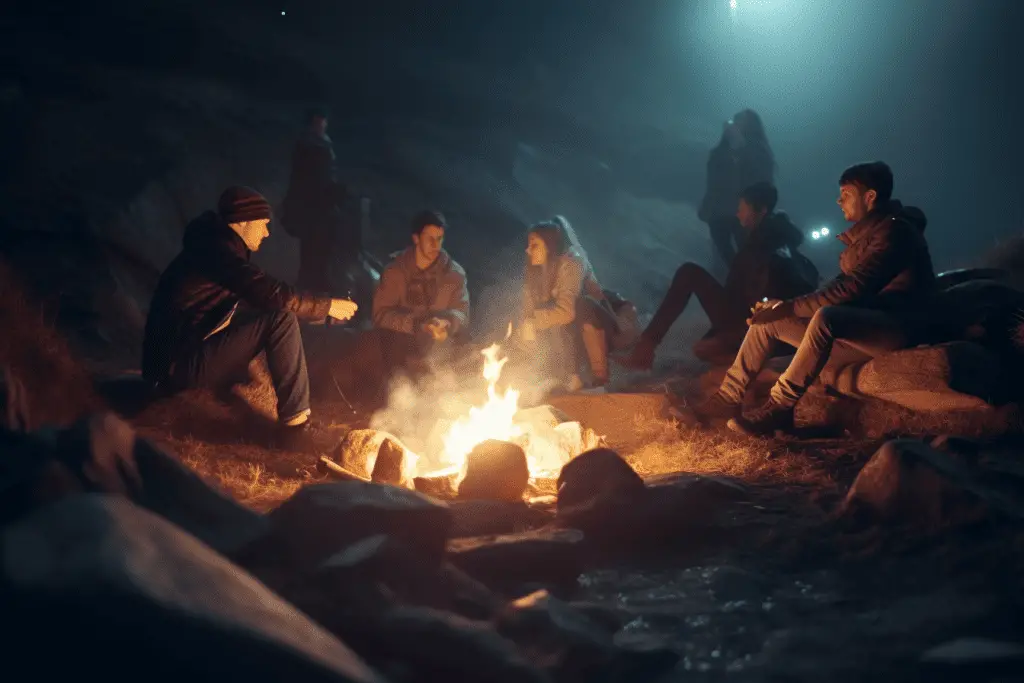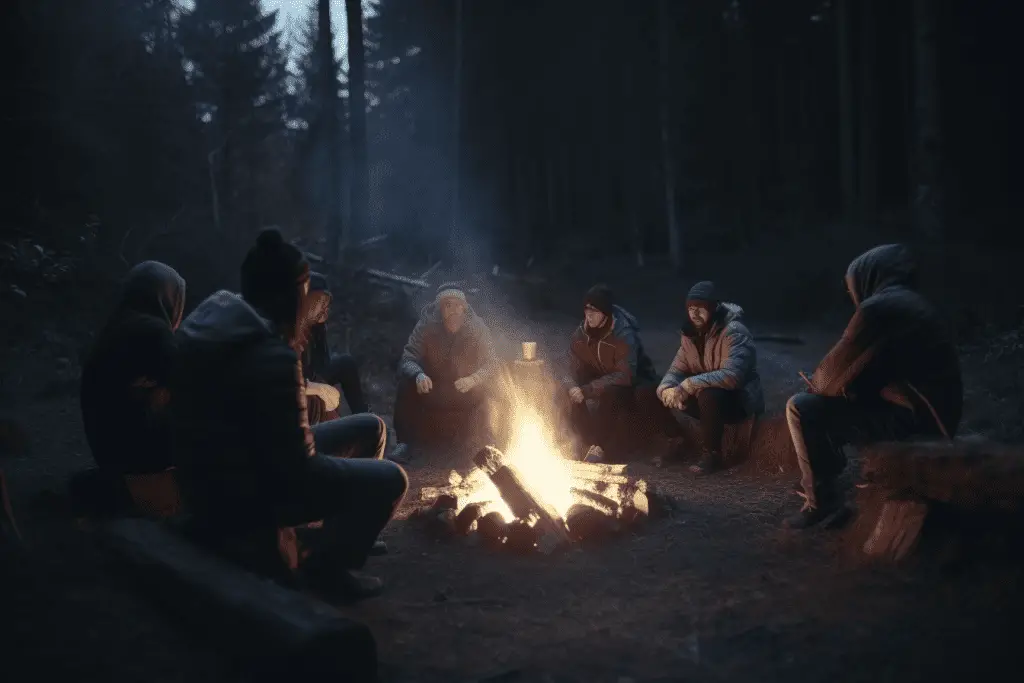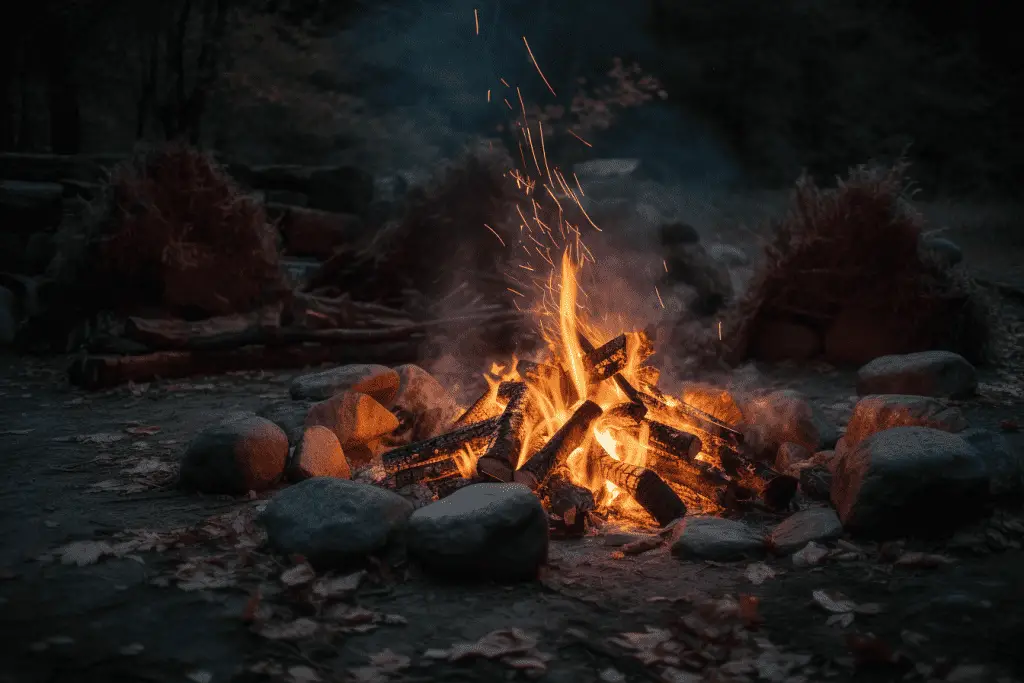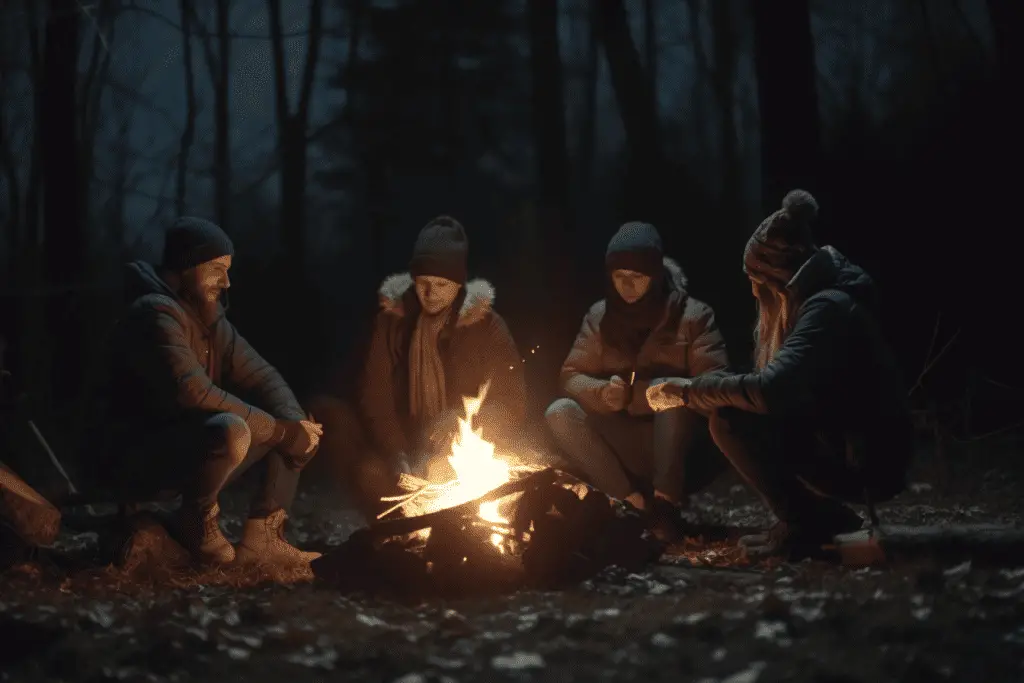We know campfires are hot enough to cook food and to provide us with extra warmth but just how hot is a campfire?
The temperature of a campfire can vary depending on the type of wood and the size of the fire, but generally, a campfire can reach temperatures of up to 1,100 degrees Fahrenheit (593 degrees Celsius).

Measuring the Heat: Typical Temperature of a Campfire
Now, have you ever thought about exactly how hot your campfire is getting? It’s not like you can just stick a regular thermometer in there – at least not if you want to use it again!
A typical open-air campfire, made using hardwood logs, can reach temperatures of about 900 to 1,100 degrees Fahrenheit in its core. That’s seriously hot – hotter than the temperature at which aluminum melts! But remember, this is the fire’s core temperature. The heat you feel when you’re sitting around it is much less, thankfully.
However, these temperatures can fluctuate quite a bit based on the factors we discussed earlier, like the type of wood, how the wood is arranged, and the weather conditions. For example, if you’re using softwoods or if it’s a particularly windy night, your fire might not reach those peak temperatures.
To measure this heat accurately, you’d need a pyrometer – a special type of thermometer that can handle these high temperatures. But unless you’re a scientist or a hardcore camper, you probably won’t need to go to those lengths.
Just keep in mind that campfires can get extremely hot, so always prioritize safety. A little respect for the power of fire goes a long way in preventing accidents and ensuring you have a fun, warm time on your camping trip.
Variables Impacting Campfire Temperatures
Have you ever sat around a campfire and wondered why it seems warmer on some nights than on others? That’s because several factors can affect a campfire’s temperature. And no, it’s not just about the amount of marshmallows you’re roasting!
First off, the type of wood you’re using can make a big difference. Hardwoods like oak or hickory tend to burn hotter than softwoods like pine or fir. That’s because hardwoods are denser and contain more potential energy that gets released as heat.
Next, the way you’ve stacked your wood can also play a part. A teepee-style fire lets air in from all sides and burns hotter and quicker, while a log cabin-style fire might burn a bit slower and cooler, but it lasts longer.

Don’t forget about the weather conditions! Wind can fan your flames and increase the temperature, but too much might blow your fire out. Cold, humid air can cool the fire down, while dry air lets it heat up more.
And finally, the age and dryness of the wood affect the fire’s heat. Freshly cut, or “green”, wood has a lot of moisture and doesn’t burn well. On the other hand, seasoned wood—that’s been dried for at least six months—will give you a nice, hot fire.
Influence of Firewood Type on Campfire Heat
Every type of wood has a unique energy content, which essentially means the amount of heat it can produce. Hardwoods like oak and hickory are denser and have more energy packed into them, leading to hotter and longer-lasting fires. Softwoods like pine and cedar, on the other hand, burn faster and cooler, but they’re great for getting a fire started thanks to their high resin content.
Also, the moisture content matters too. Seasoned wood—that’s been dried for at least six months—is the ideal choice. It burns hotter and cleaner because it has less moisture to boil off. Green wood, or freshly cut wood, has a lot of moisture that uses up heat to evaporate, leaving less heat for you to warm your hands or roast your marshmallows!
Now, here’s a quick rundown of common firewood types and how hot they usually burn:
| Firewood Type | Heat Output (Ranked from High to Low) |
|---|---|
| Oak | Very High |
| Hickory | Very High |
| Maple | High |
| Ash | High |
| Birch | Medium |
| Pine | Medium |
| Cedar | Low |
| Fir | Low |
Remember, it’s not all about heat. Each type of wood brings something unique to your fire, like pleasant aromas or pretty flame colors. So, choose your wood wisely based on what you need from your campfire!
Flame Colors and Their Temperatures: Reading the Fire
Alright, let’s add some color to this conversation! Ever been mesmerized by the vibrant hues dancing in a campfire? Those colors aren’t just pretty to look at—they can actually tell you a lot about the fire’s temperature.
Here’s the basic science: when you heat up different elements, they emit light at specific colors. For a campfire, you’re mostly dealing with compounds in the wood that glow when heated. The range of colors in a fire comes from the different temperatures of the flames.
A red flame, which you’ll usually see near the base of the fire or on glowing embers, is the coolest. It’s around 1,112 to 1,832 degrees Fahrenheit—still pretty toasty though! If your fire is producing orange flames, it’s getting hotter, between 1,832 and 2,192 degrees. Yellow flames are even hotter, and they’re often seen flickering near the tips of the flames.
But if you see blue flames, like you might in the heart of the fire or when you’re burning something like propane, that’s the hottest a flame can get in typical conditions, often exceeding 2,400 degrees Fahrenheit. White flames are also extremely hot, but they’re rarely seen in a campfire—more often in a lab or a forge.
Here’s a simple table that shows various flame colors and their approximate temperatures:
| Flame Color | Temperature Range (°F) | Temperature Range (°C) |
|---|---|---|
| Red | 1,112 – 1,832 (°F) | 600 – 1,000 (°C) |
| Orange | 1,832 – 2,192 (°F) | 1,000 – 1,200 (°C) |
| Yellow | 2,192 – 2,372 (°F) | 1,200 – 1,300 (°C) |
| Blue | 2,372 – 2,732 (°F) | 1,300 – 1,500 (°C) |
| White | Above 2,732 (°F) | Above 1,500 (°C) |
Keep in mind, though, that colors can be affected by other factors as well, like chemicals in the wood, so it’s not an exact science. But it’s still a fun way to get a general idea of your campfire’s heat while you’re toasting those s’mores!
So, next time you’re around a campfire, impress your friends with your newfound fire color knowledge. Just remember to stay safe and enjoy the natural light show!
How the Campfire Temperature Decreases Over Time
Just like a good party, a campfire doesn’t stay hot forever. It cools down over time, and understanding this process can help you manage your fire more effectively, not to mention safer.
When you first light your fire, it takes a bit of time to reach its peak temperature. That’s because it needs to drive off the moisture in the wood and get the combustion process really going. Once it’s roaring, your campfire can maintain its heat for a while, especially if you’re adding more wood.
However, as the fuel burns down and turns into embers, the temperature starts to drop. These embers still radiate a good amount of heat and are perfect for cooking, but they’re not as hot as the fire was in its prime.

Now, if you stop adding new wood, the fire will continue to cool. The embers will slowly turn into ash, which doesn’t burn and, therefore, doesn’t give off much heat. Eventually, if left undisturbed, the campfire will cool down to the ambient temperature.
This cooling process can take several hours, so it’s important to keep an eye on it, especially if you’re about to head to bed or leave your campsite. Even if a fire looks out, it can still be hot enough to reignite or cause burns. So, always make sure your fire is completely out, not just cool to the touch, before leaving it unattended.
That’s your crash course in the life cycle of a campfire’s heat! It’s a bit like watching the life of a star in fast forward, don’t you think? Just another thing that makes campfires so fascinating!
Maximizing Efficiency: How to Manage Your Campfire Heat
Whether you’re cooking dinner, warming up after a hike, or just setting the mood for a night under the stars, efficient heat management can make your campfire work better for you.
First things first, the type of fire lay you choose can impact the heat output. For a quick, hot fire, the teepee structure is your friend. It allows plenty of oxygen to reach the flames, fueling a hotter burn. But if you’re looking for sustained heat, consider a log cabin or pyramid structure. They burn slower and steadier, offering a consistent warmth over a longer period.
Then comes the type of wood. As we mentioned earlier, hardwoods like oak and hickory provide a hotter and longer-lasting fire, while softwoods burn faster but cooler. For the most efficient fire, start with softwood kindling to get things going, then add hardwood logs to keep it hot and glowing for hours.
One of the biggest keys to efficiency is air flow. Fire needs oxygen to burn, so arranging your logs to allow good airflow will keep your fire burning hotter and cleaner. But watch out for the wind! While it does provide oxygen, too much can cause your fire to burn through your fuel quickly.
Finally, remember that a campfire is a bit like a pet—it needs your attention. Don’t just light it and forget it. Monitor your fire, add logs as needed, adjust its structure, and remove excess ash that can choke out the heat.
With these tips, you’ll not only get the most heat from your campfire, but you’ll also make your fuel last longer. And that’s a win-win in any camper’s book!
Extinguishing the Blaze: When the Heat is Too High
Let’s cool things down a bit and talk about extinguishing a campfire when it gets too hot. We’ve all been there: you’ve got a roaring campfire going, and it’s perfect for toasting marshmallows, but then it starts to get a bit too big and a bit too hot. So, what do you do?
The first rule of thumb, when a campfire gets too hot, is to stop adding fuel. It might seem obvious, but sometimes in the excitement of the moment, it’s easy to forget that adding more wood will only make the fire bigger and hotter.

Now, if you want to reduce the heat without extinguishing the fire entirely, you can rearrange the wood to lessen the intensity. Use a long stick or fire poker to spread out the logs, which will reduce the concentration of heat. Be careful while doing this and avoid any direct contact with the fire.
But if it’s time to call it a night, or the fire is just too hot to handle, you’ll need to extinguish it completely. The best way to put out a campfire is to use water. Douse the fire thoroughly, making sure all the embers are wet. You should hear a hissing sound—that’s the sound of your campfire safely going out.
But don’t just walk away after the hissing stops! Stir the ashes with a stick to make sure all the heat has been extinguished. The goal is to make sure everything is cool to the touch. That’s when you know your fire is really out.
Remember, a good camper leaves no trace. That includes making sure your campfire is properly extinguished. So, next time your campfire gets a bit too lively, you’ll know just what to do!
Moving Forward: Campfire Management
We’ve journeyed from the spark of ignition to the last whisper of smoke, exploring the hot and cool aspects of a campfire. Understanding the various elements that influence its temperature—from the type of wood used, how it’s stacked, and even the dance of colored flames—can make a world of difference. It can enhance your safety, elevate your marshmallow roasting, and let’s be honest, make you the coolest fire-tender in your camping circle!
So next time you’re out in the wilderness, huddled around a crackling fire, you’ll know the ins and outs of that mesmerizing blaze. Managing a campfire is an art, and now, you’re an artist. So here’s to safe, warm, and responsible campfires—where stories are shared, meals are cooked, and memories are made.
